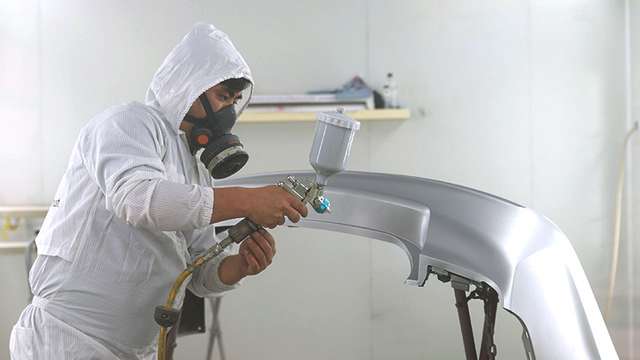- body
What types of paint are used on cars?

Updated 2 Dec 2020
Jonathan Nash

When you decide the time is right to buy a new car, one of the things you’ll no doubt take into account at decision time is colour.
Black, white, red, green, blue . . . there’s usually enough choices to please anyone’s taste and, in most cases, manufacturers will have variations of these base colours too.
These can come with some very imaginative names.
Take a tour through the websites of some of the big manufacturers and you’ll find there’s Velocity Blue, Blue Lightning, White Platinum, Lunar Silver, Phoenix Orange, Cosmic Grey, Dark Knight, Tangerine Comet, Acid Yellow, Frozen Red . . . the list goes on and on and one wonders whether members of marketing departments were puffing blunts of the strongest strains of Jamaican Gold during late-night ‘name-the-colour’ brainstorming sessions.
Bonkers names aside, some of these colours will be available in paint options known as solid, metallic, pearlescent or matte. But what do these terms mean?
A colour is a colour, right? Sort of.
For these terms relate to paints that, through additives as well as via application and treatment, give the colour a whole different look and feel.
Here’s a quick look at the main type of paints used on cars today:
1: Solid paint
The most common form of paint and the one that you’ll find on many freshly unwrapped, just-out-of-the-factory cars. Its shiny, gleaming appearance comes from the application of a high-gloss clear coat.
Solid paint is the most reasonably priced paint option – a feature reflected in the price of the vehicle itself.
Other paint choices on this list may be an option but will cost you extra.
Solid paint is the easiest to colour match should any respraying or repair work need to be done.
2: Metallic
Essentially solid paint but with metal flecks or powder added into the mix.
These flecks result in the paintwork reflecting much more light, giving the vehicle an unmistakeable sheen and a glittering effect.
You’ll pay a premium for this type of paint and if it needs repairing or touching up it can be more difficult to colour match.
3: Pearlescent
Pearlescent paints are much the same as metallic paints except they use flecks of ceramic instead of metal.
It has the ability to both reflect and refract light, enabling the paint to appear to shift in colour depending on the angle from which it is viewed – a colour shift known as the ‘pearl’ effect.
Pearlescent paint is most often used on high-end luxury vehicles and, as with metallic paint, it is trickier to colour match or repair if scratched or damaged.
It’s expensive too, so expect to pay a juicy premium if you need work done.
4: Matte
A bit of an unusual one is this and given that it is still an uncommon choice for most car owners, it’s an option that can turn heads out on the street.
Most often associated with the sportier or luxury end of the car spectrum, the matte paint look is achieved via the clear coat layer applied to the paint.
The clear coat, thanks to imperceptible dimples and dents, ‘dulls’ the paint’s appearance, reducing light reflection off the car and giving it a flatish appearance.
While these paints cover the main options available on new cars from manufacturers, there are almost no limits to what can be achieved in the aftermarket world.
If you want, and you have the money, all manner of fantastical paint choices are available and, in the hands if a talented spray painter, some amazing results can be achieved.
There’s chameleon paint that displays multiple colours; there’s thermochromic paint that changes colour according to its temperature; there’s paint that can give your car’s bodywork a rusted, old-time, tarnished appearance; and there’s glow-in-the-dark paint too.
For those really wanting to make a statement, there’s even electroluminescent paint that can light up at the flick of a switch.
It’s amazing what can be done. So, assuming you can afford it, you could think about giving your imagination a workout to come up with something unique.
Perhaps give it a wacky name too . . . no blunt required.

Written By
Jonathan Nash
Jonathan has been writing about the auto industry for years and is particularly interested in the high-tech innovations sweeping the industry.
He’d love to own a Tesla Model S, but also adores anything with a V8 under the bonnet.
He has yet to decide between an EV or a Mustang for his next ride.